netty 中 ChannelFuture.sync () 的作用是什么?
如果你使用过 netty,你一定见过下面两行代码,它们可以说是创建一个 netty server 的标配代码
1 | ChannelFuture future = bootstrap.bind(port).sync(); |
不知道你有没想过这里面的 sync() 的作用是什么,如果去掉会有什么问题?
bootstrap.bind (port).sync () 分析
先来一步一步分析下第一行代码中的 sync 的作用
现象跟踪
为了方便调试,我把主要的代码贴到的下面,至于 EchoServerHandler 比较简单,你可以随便写个
1 | EventLoopGroup eventLoopGroup = new NioEventLoopGroup(); |
回到这行代码
1 | ChannelFuture future = bootstrap.bind(port).sync(); |
我们可以把它拆成两行
1 | ChannelFuture future1 = bootstrap.bind(port); |
debug 下你会发现,future1 和 future2 其实是同一个对象
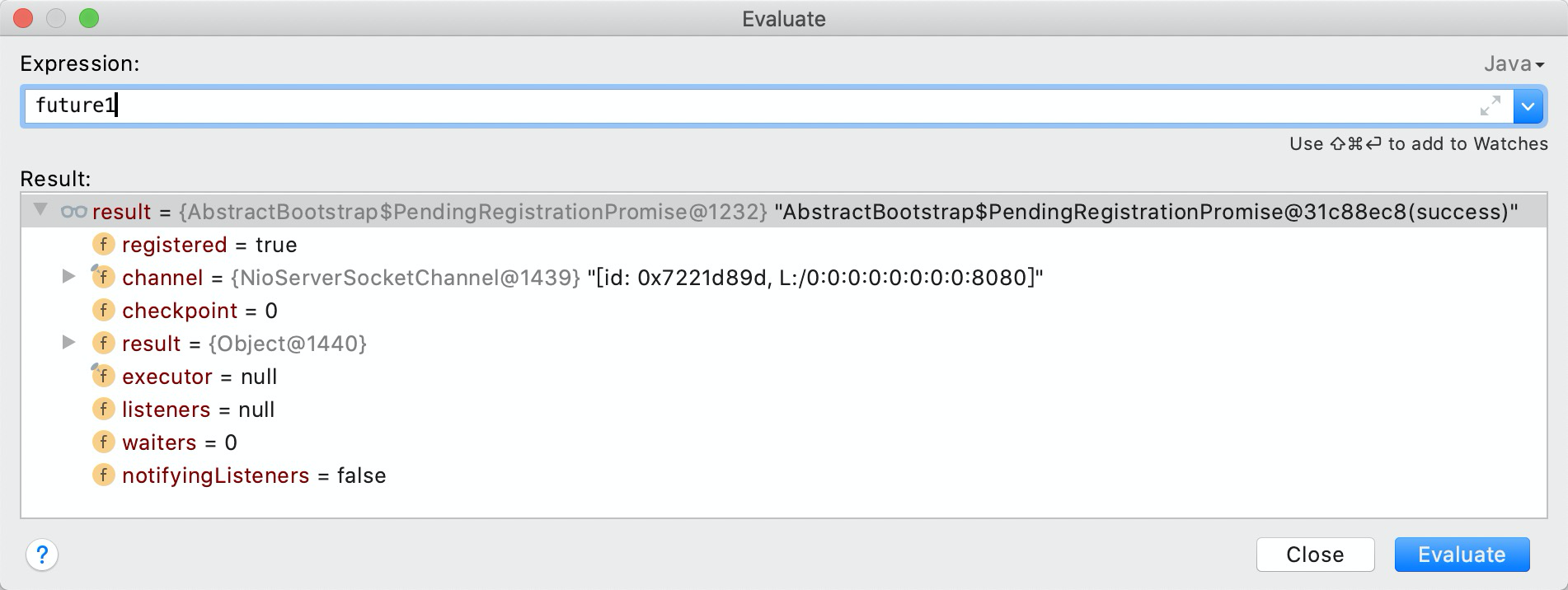
image-20210128004713080
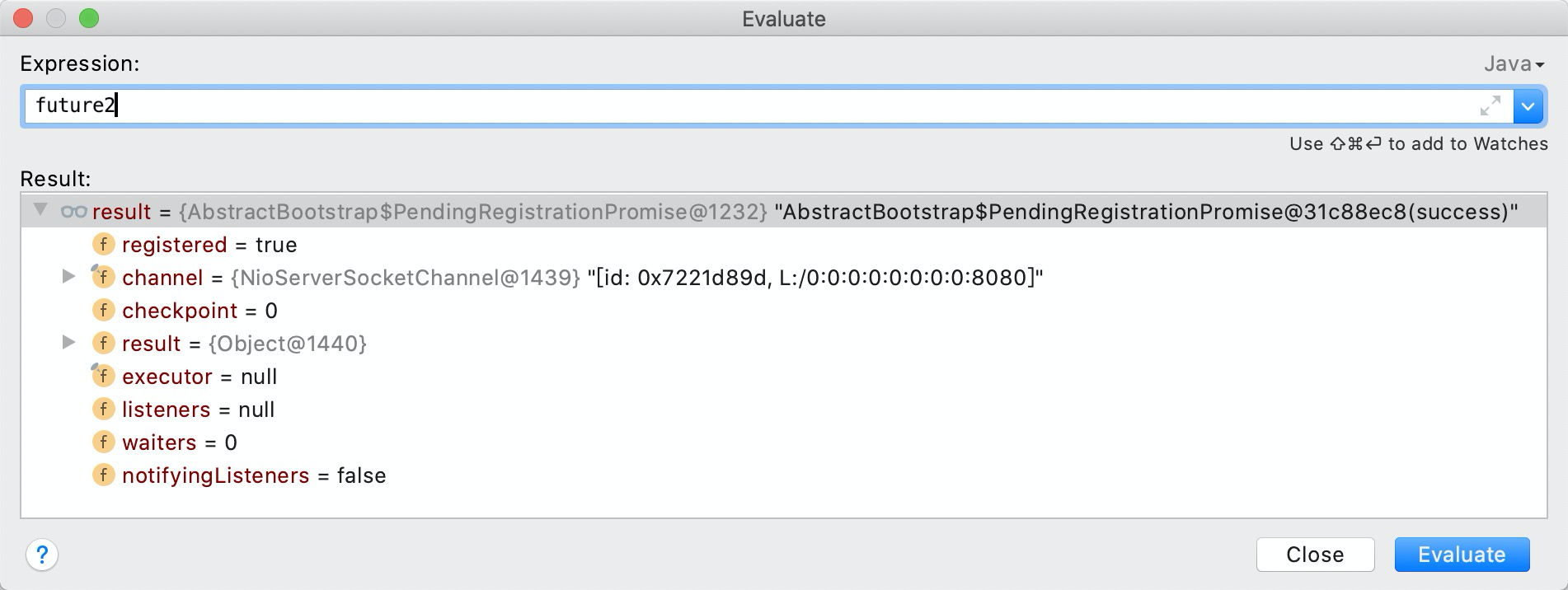
image-20210128004734859
那么这个 sync 有什么作用呢?从名字上看是同步,猜测执行后会等待某种事件。将断点放在 future2 执行前再次 debug
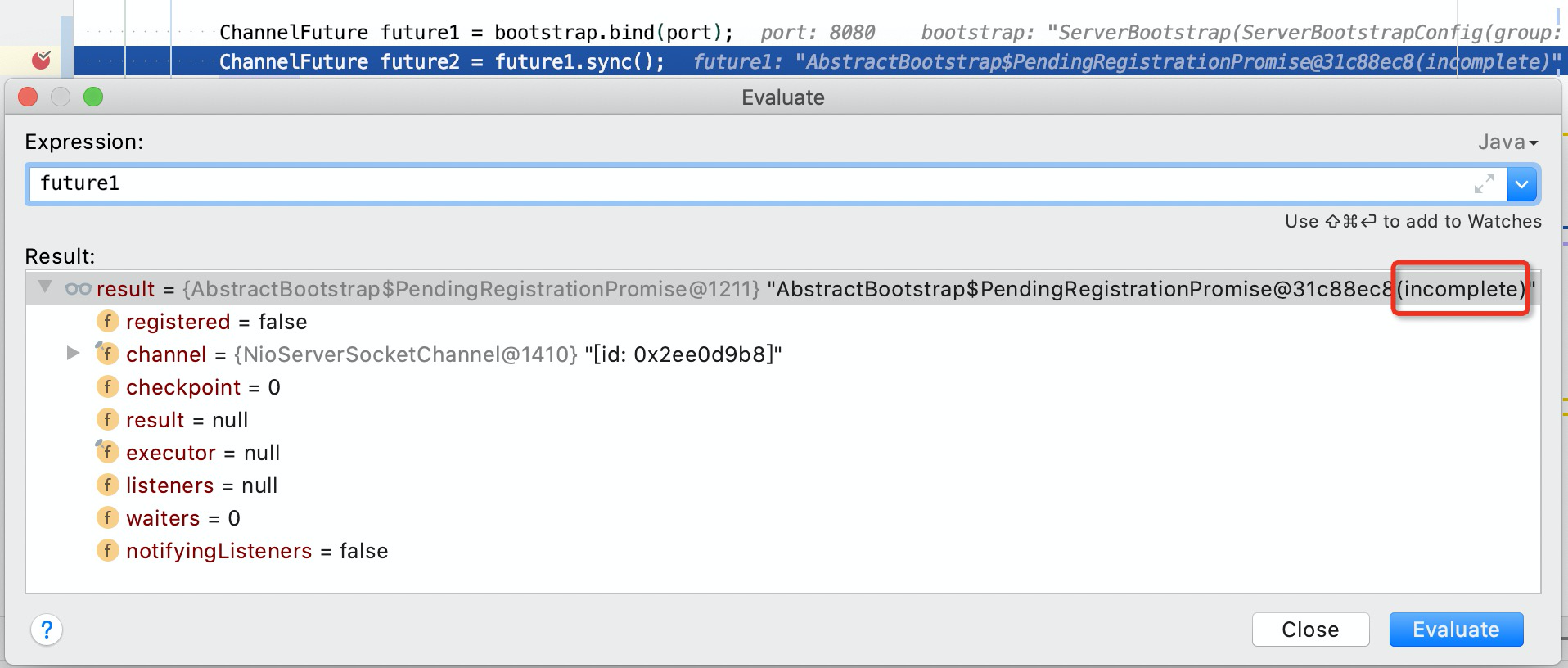
image-20210128005025015
你会发现事情起了变化,future1 执行 toString () 的结果中有一个 incomplete 字样,是一个未执行完成的状态
继续执行 future1.sync() 并查看状态

image-20210128005401882
此时 future1 的状态变成了 success。这说明 future1.sync() 会等待异步事件执行完成,并且返回自身,可通过以下代码进一步验证
1 | ChannelFuture future1 = bootstrap.bind(port); |
在 future1.sync() 之前 sleep 1 秒钟,等待异步事件执行完,再次 debug 查看 future 状态
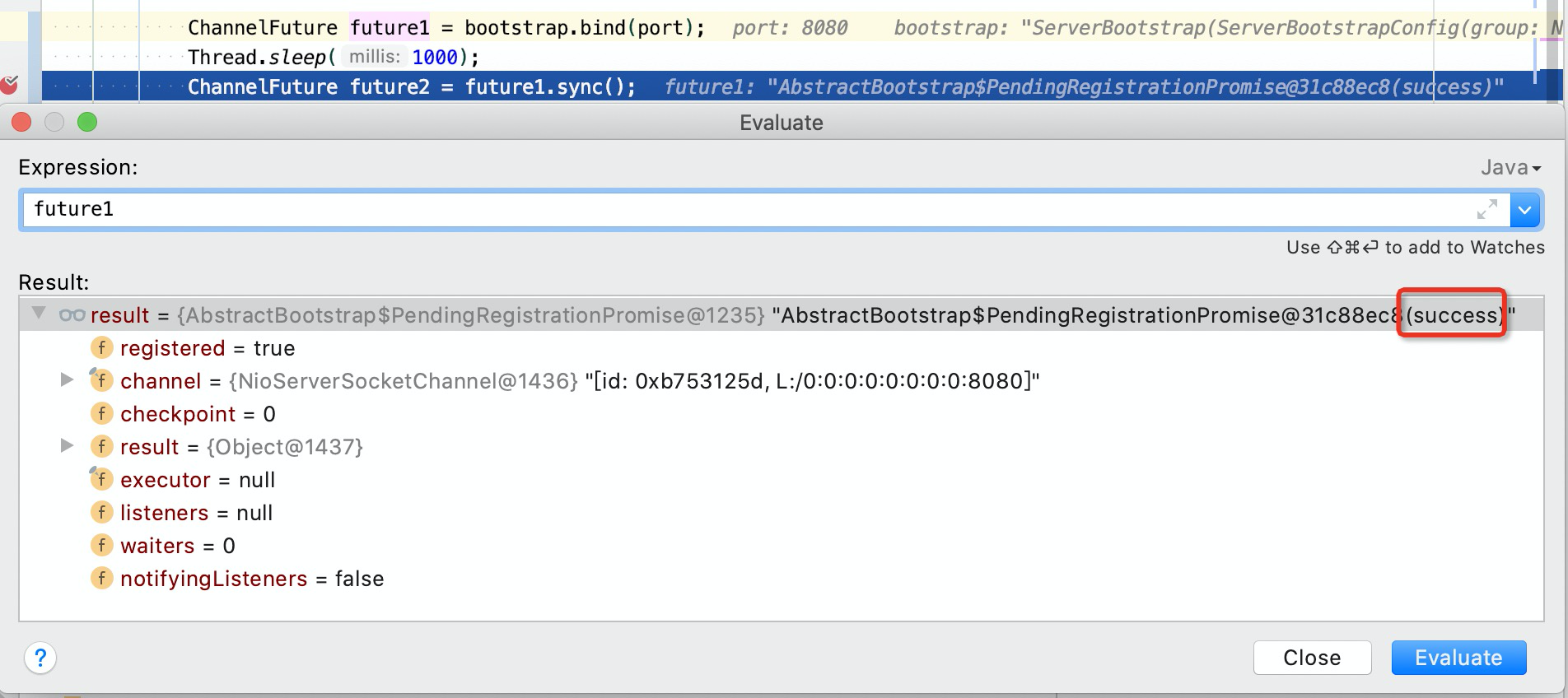
image-20210128005834185
此时 future1 已经是 success 状态
代码分析
bootstrap.bind(port) 返回了一个 future 对象,它是一个 AbstractBootstrap$PendingRegistrationPromise 类型的实例
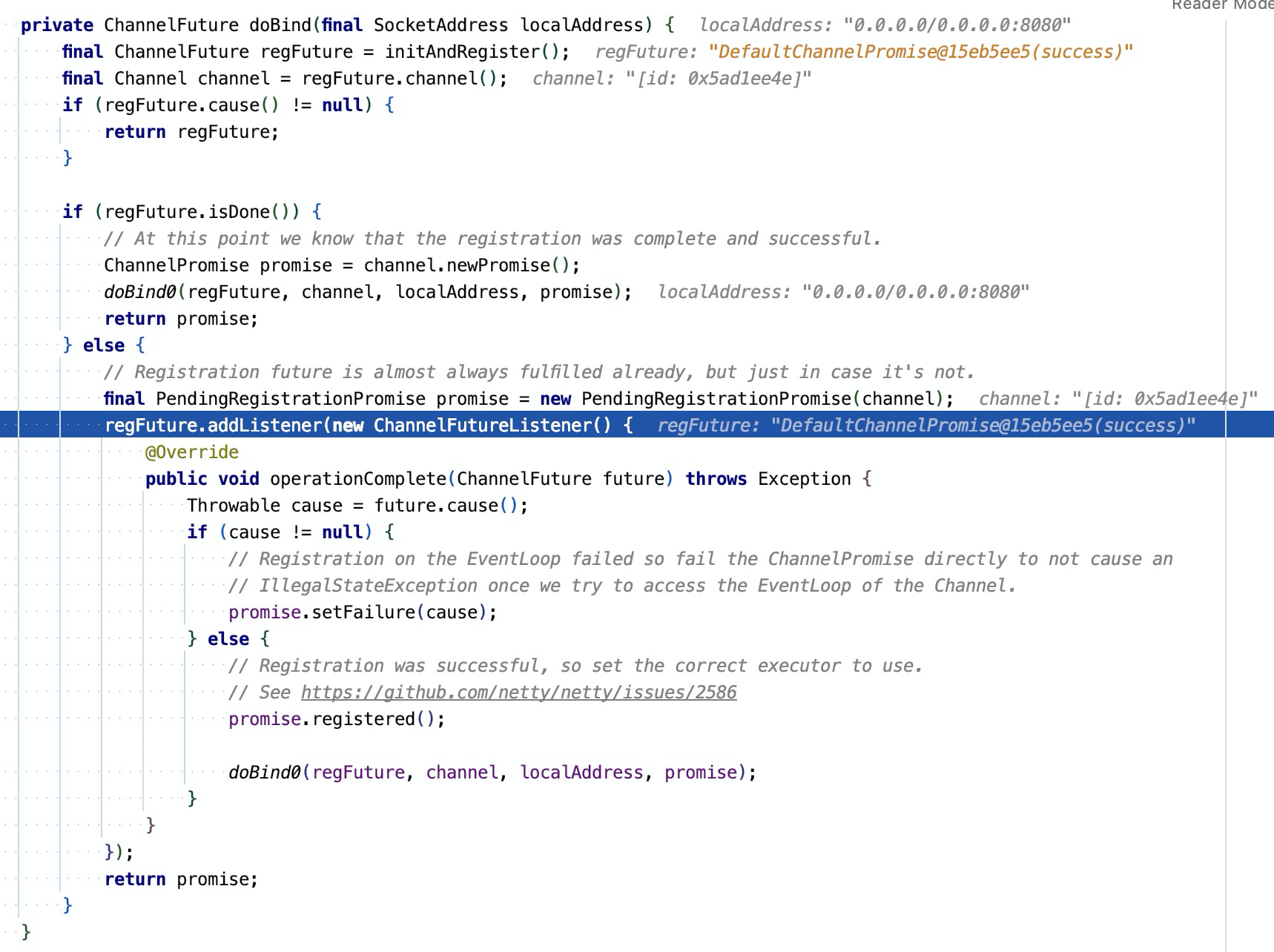
image-20210128010446182
PendingRegistrationPromise 持有了 channel 的引用,并且往 ChannelFuture 注册了一个 Listener,当 ChannelFuture 的任务处理完成后,根据执行结果是否有异常决定执行 promise.setFailure 或 promise.registered 方法,若执行成功,则继续执行 doBind0 方法进行绑定操作。
回到上层,接着跟踪 future.sync 的内部执行逻辑,逐步跟踪进行,会发现执行到 DefaultPromise 的 await 方法
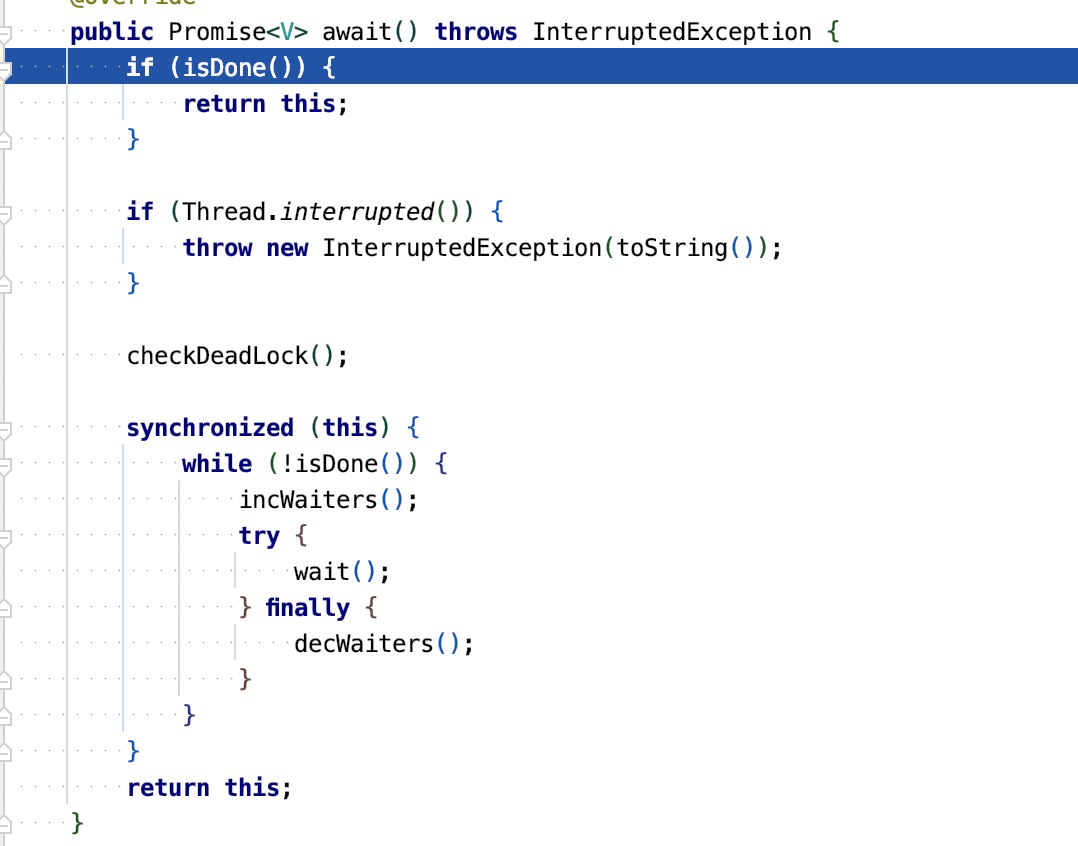
image-20210128011324372
isDone 会判断 result 的状态
1 | private static boolean isDone0(Object result) { |
因为此时 result 为 null,所以返回 false,继续往下执行
最终会执行到 while 循环中,将 waiters 变量的值加一,并且进入到 Object.wait () 中,等待被 notify 或 notifyAll 唤醒
1 | while (!isDone()) { |
那么它是被谁唤醒的呢?debug 跟踪 promise.registered 的执行,会发现它并没有修改 promise 的执行状态,继续跟踪 doBind0 方法
1 | doBind0 |
经过层层地跟踪,最终会执行到 AbstractUnsafe.bind 方法

image-20210128014247167
注意最后一行,它是用来设置 future 的执行结果状态的,可以看到在执行前的状态是 uncancellable。跟踪进去
1 | protected final void safeSetSuccess(ChannelPromise promise) { |
关键的代码是 promise.trySuccess
1 | DefaultChannelPromise.trySuccess |
1 | AtomicReferenceFieldUpdater<DefaultPromise, Object> RESULT_UPDATER = |
最终会通过 cas 操作将 AbstractBootstrap$PendingRegistrationPromise 的 result 属性设置为 SUCCESS,然后通知 waiter 和 listener
继续跟踪 checkNotifyWaiters 方法
1 | private synchronized boolean checkNotifyWaiters() { |
它会检查 waiters 变量的值,若大于 0 则说明有线程执行了 Object.wait 方法,此时通过 notifyAll 唤醒所有的线程,至此也就将整个过程串联了起来。
总结
bootstrap.bind() 返回一个 AbstractBootstrap$PendingRegistrationPromise 对象,它本质上是一个 DefaultPromise 对象,实现了 Future 接口
future.sync() 最终会使 DefaultPromise 的属性 waiters 值加一,然后调用 Object.wait 方法阻塞等待
bootstrap.bind() 会提交绑定事件到 EventLoop 中执行,待 socket 绑定地址成功后会调用 DefaultPromise 的 trySuccess 方法更改其状态并通知所有 waiter
此处 future.sync() 目的是等待异步的 socket 绑定事件完成
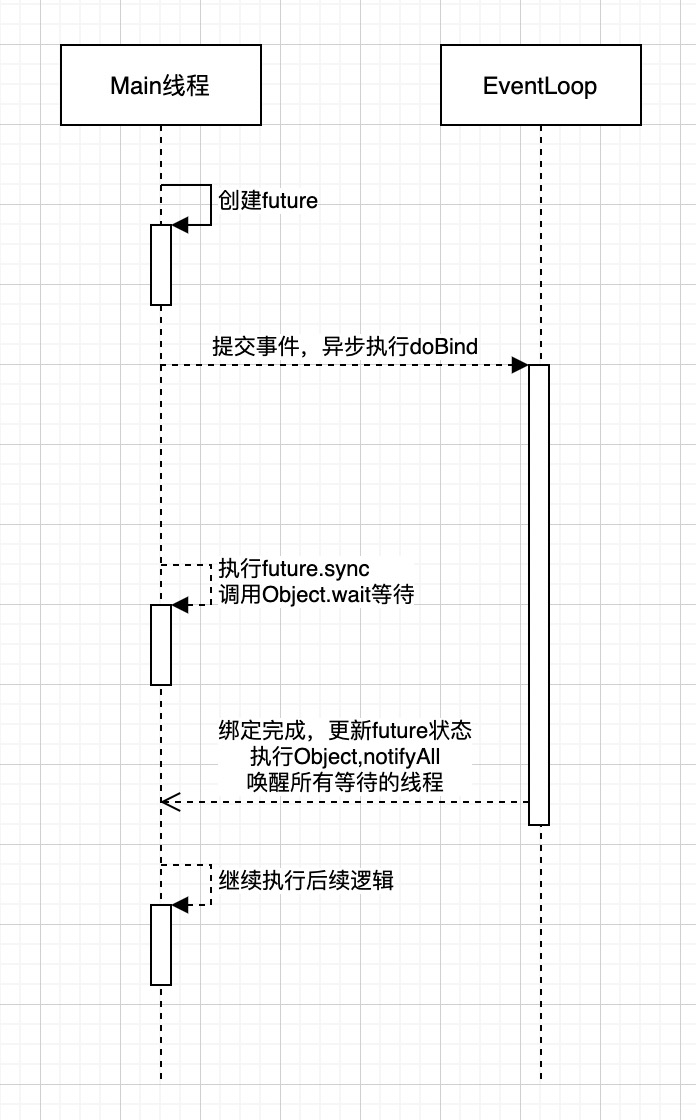
image-20210128020412505
future.channel ().closeFuture ().sync () 分析
有了上面的经验,再看这行代码就轻松多了
代码分析
为了便于理解,我将这行代码拆开并加上了注释
1 | // 获取ServerSocketChannel |
这里面需要关注的是 closeFuture,它的定义如下
1 | private final CloseFuture closeFuture = new CloseFuture(this); |
可以看到 CloseFuture 类只提供了一个 setClosed 方法,调用后会将其自身的状态设置为 SUCCESS。
如果还未调用过 setClosed 方法,执行 closeFuture.sync() 方法会阻塞在 Object.wait() 上,等待被唤醒。
那么在什么情况下会调用 setClosed 方法呢?跟踪代码引用情况,你会发现在 register 和 close 两个时机都有可能调用

image-20210129004510287
它们之间的区别是,在 register 阶段,只有当出现异常的情况下会调用 closeFuture.setClosed() 方法

image-20210129004814557
而在 close 阶段,因为本身就是要关闭,所以不管成功或出现异常都会调用,只是在抛异常的情况下会记录异常栈
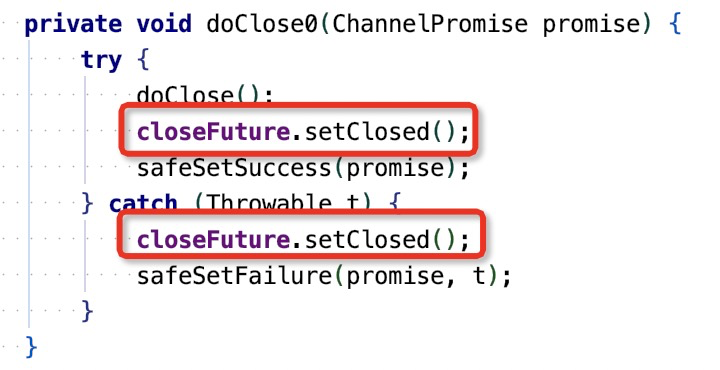
image-20210129004935112
总结
1 | ChannelFuture future = bootstrap.bind(port).sync(); |
再回顾下代码,这里面共有两个 Future 对象:
bind方法返回的 future 用于等待底层网络组件启动完成- closeFuture 用于等待网络组件关闭完成
- 2021-02-03
netty 使用
DefaultPromise完成异步操作,它对 jdk 的 Future 进行了扩展,提供了更丰富的功能。 - 2021-02-05
netty 是一个基于异步事件驱动实现的网络编程框架,它的内部使用了大量的异步编程方法,这是它性能高效的一个原因,但同时也使得代码阅读起来更加困难,本文就尝试分析下它的启动过程
- 2021-02-26
对于一个 Netty client 来说,在配置好
Bootstrap之后,通过调用其connect方法来连接到远程服务端,如下所示1
2
3
4Bootstrap b = new Bootstrap();
b.group(group)
...
ChannelFuture f = b.connect(HOST, PORT).sync(); - 2021-09-08
通过 netstat 命令查看网络状态,其中有一列展示的是 socket 的状态,熟练掌握这些状态的含义有助于连接状态的分析与问题排查。
- 2021-01-26
ServerBootstrap 启动时需要初始化 ServerSocketChannel 并将其绑定到 EventLoop 上,用于处理该 channel 上产生的各种事件。那么 ServerSocketChannel 是如何完成创建和初始化的?又是如何绑定到 EventLoop 上的?
预览:
学习了,谢谢分享!
@iupikachu: 欢迎欢迎
欢迎欢迎
分析的很清楚,学习了